29/07/24 - Can the beautiful tale of the Prarostino Pioneers be repeated?
The return of Trial to Prarostino with the Two Days of the Pioneers, scheduled for next 26 and 27 October, brings to light almost twenty years of memories of a fantastic race that was able to involve all the enthusiasts, committed to that fixed event at the end of the season, always in a great festive atmosphere.
The Moto Club Gentlemen's of Pinerolo was the creator of an event that already in the 1980s wanted to propose an easier Trial and within everyone's reach, because it was essentially aimed at motorcycles defined as "old", but also at riders who we would call "elderly". ", because their age "did not avoid good humor", given the accumulated bonuses to be deducted from the penalties in the sections.
It was inspired by a similar race organized first by Claude Coutard and then by his son Charles, top rider in the 1970s world championship, in Rochepaule, a town in the Ardèche region of France.
The first edition took place in 1984 in San Secondo-Prarostino - a small town not far from Pinerolo - which already enjoyed a fair reputation in the international trials field, because it had hosted several "two days" open to pilots of all levels: from the world star, see Bernard Schreiber, Toni Gorgot, Giles Burgat, just to name a few, the last of our "cadet" pilots. Equal sectioms for everyone: at the end of the 70s, beginning of the 80s it was possible, provided that whoever was setting them had adequate preparation in this regard. There was no shortage of these people within the famous Pinerolo club.
Today only the Six Days of Scotland and the Scott Trial persist, as races in which the sections - no longer all - can be done by amateurs and professionals without distinction.
And precisely because the evolution of the specialty was beginning to mark important milestones, the coexistence between pilots of different levels on identical tracks was becoming almost a utopia.
At the same time, the feedback from Italian enthusiasts who had crossed the border to try Coutard's transalpine classic had been very positive: therefore the conditions for creating something similar here too, suddenly became a reality.
Thus wrote the late Ferruccio Garis - president of the Gentlemen's at the time - in a very precious photographic diary, accompanied by all the results:“Always looking for new manifestations, on the path of what was conceived by Monsieur Coutard in France , the club managers propose the 1st PIONEERS TRIAL, a competition reserved for pilots at least 35 years old.” .
It was the weekend of December 8th and 9th. A single lap of 15 sections on both days with secions all changed on Sunday. There were three categories: Pioneers, Aspirants and Vintage Motorcycles. The Pioneers were all those over 40, the Aspirants were those between 35 and 40, the Vintage Motorcycles were those before the release of the Bultaco Sherpa 1965. The most striking innovation was the Handicap table. Those in their forties determined the year zero. From 35 to 40 there was 1 penalty point for each year under 40. While one bonus point was due for each year post-40, which became two points for post-50. Seventy-eight pilots responded to the appointment.
It was obvious that the orientation was more towards a recovery of elderly pilots in evident difficulty with the progressive change of the specialty, indeed that frenetic search to present ever greater difficulties, never appeased, as can be seen from the clear examples of today.
The following year it was proposed again on 27 and 28 July at 2000 meters above sea level in Sestriere and it was a big mistake. There were still around seventy participants but the date and location were not appreciated. However, the media coverage was superlative, given the prominent tourist location and this served to give impetus to this type of competition, which was decidedly against the grain. Several foreign riders also showed up at the start, contributing to that touch of internationality, which has increased over the years.
In 1986, the third edition, here was the return to San Secondo di Pinerolo and Prarostino. The date was set once and for all: the last weekend of October, never changed thereafter. This wandering of dates and locations did not help the growth of consensus, which did not vary compared to previous years, always a niche of around seventy.
But in 1987 there was a first turning point. The race was also open to riders aged between 30 and 35, establishing the "Baby Bottle" category for them and following the principle of assigning two penalty points for each year that separated them from 35 years of age. Furthermore, the number of Pioneers doubled, bringing the number of participants to 137, with several foreigners competing including the honorable presence of Claude Coutard.
Formula confirmed also for the following year, with more than 150 attendees in an always convivial atmosphere, made particularly festive by the dinner on Saturday evening. To flesh out the Vintage Motorcycles category, in addition to foreign pre-65s, Italian motorcycles produced before 1975 were added.
In 1989 the departure returned to Prarostino. Illustrious guest was the multiple European champion, as well as instructor in many schools around the world, Mick Andrews,whose "young" age denied him victory in the Pioneers category. Andrews (born 1944) came fourth among the Pioneers with a score of -5, beaten in that order by Luciano Gianazza (Fantic, born 1939) -8, Walter Stoll (Honda, 1939) -8, and Giovanni Tosco (SWM, 1942 ) -7. Andrews had cleaned all the course, as had Tosco, while Gianazza and Stoll had set 2 dabs. But the race's spirit of rewarding older riders meant he missed out on success.
Seventh edition in 1990 with almost 230 riders at the start. Pilots from Austria also arrived, in addition to the usual Swiss and French. First signs of environmental restrictions with the Forestry Corps on the field to monitor the route on which the race took place. Finally a greater participation of Old Motorcycles and a greater interest in that direction. Greater professionalism in drawing up the rankings, now entrusted to a software company, which was not at all a given in those years.
The 1991 was another year of great news. The intention to give greater weight to truly ancient motorbikes pushed the organizers to make differences in the categories.
Only the Pioneers were allowed to race with modern motorbikes. There were three other categories, all linked to Vintage Motorcycles: the Artisan ones - given that trialists have never lacked ingenuity and creativity - prior to 1968; the Classics, understood as those of the European Championship, years 1968-1974; finally those Two Shock Absorbers, post 1975.
The disruption of the revolution in the categories caused a decline in participations, which stood at around 150, but as will be seen in the following years the solution will prove successful.
The year 1992 also saw an increase in Vintage Motorcycles and participants, especially in the Pioneers category, which were ultimately the objectives of this event. That began the search for a twin-shock absorber model to keep in the garage and use only for this race, whose maintenance was often trivial and summary. Nobody - or few - was interested in the ranking, because it was distorted by age bonuses. Everyone ran for their own performance: ah... if only we could replicate it today!
The tenth anniversary was reached in 1993, with around 200 at the start. This record is a first success after the new regulations. A special jury was responsible for awarding even the antique motorbikes that best corresponded to reality and someone even intervened just to show off the result of a long restoration.
In 1994 the Regional Vintage Motorcycle Trophy was established in Piedmont with 5 rounds, so the Pioneers' Trial also underwent some adjustments to adapt the categories of vintage motorbikes. There were 4 diversifications: Historical, i.e. pre-67; Classics from '68 to '76 inclusive; Post Classiche, after 76 but always with 2 shock absorbers; Artisanal, all those of artisanal construction that cannot be dated. The Pioneers were split between Twin-Shocks and Mono. The 240 participants achieved an unprecedented success. Sector and non-sector newspapers paid a great deal of attention.
In 1995 the level of the sections was split, i.e. an additional level was introduced, defined as "facilitated". The categories returned to those before 1994, more inspired by the similar French competition. For Aspiring and Pioneers the choice between Experts and Amateurs loomed. While for Vintage Motorcycles the category was unified, introducing a handicap table that took into account the age of the motorbike. It was the year of the invitation to the English star Sammy Miller, the man of 1000 victories, multiple European champion and well-known designer-tester of Trial motorcycles starting with Bultaco, with whom he rode. He won the duel with Tosco, in a race with over 250 participants.
Tosco's revenge was ready the following year with Sammy Miller again at the start, then 62 years old, riding a Bultaco made available by an enthusiast, like the previous year, but this time he had to undergo some adjustments to make it competitive from the start. expert, just passed away Giancarlo Bertani on Saturday evening. Rules confirmed as well as the number of pilots, just under 250.
From 1996 until 2001 no further changes in the groupings. Increasing number of motorcycles with twin-shock absorbers and even pre-65 ones, unusual for our country with a recall of 260-270 riders, even with a stop at 270 to guarantee a race without excessive queues for all participants.
Unfortunately, in 2001 the bad thing happened: a spectator outside the tape of a section, perhaps frightened by the oncoming motorbike, lost his balance, fell backwards into a slope and lethally hit his head on a stone. The 67-year-old spectator - not linked to the Trial circus, who died despite being immediately transported to hospital, marked the unexpected epilogue of this event, because the president of the motorcycle club, the clerck of the course, the section observer and the pilot in transit at that moment were put under investigation. The trial lasted several years and fortunately ended with the acquittal of those involved. The Federation's insurance had to compensate the family for a large sum, while the suspects had to pay the legal costs and a huge scare.
For years there was no question of running again in Prarostino and that traditional and glorious event closed its doors with that tragic 18th edition.
Recently, under the aegis of the ASI promotion body, other races were held in Prarostino, valid for the ASI North West Trophy and there were no accidents. The fatality of what happened in 2001 was absolutely a rarity, but the state of mind of those who had to remain on tenterhooks for years awaiting the verdict of the trial is more than understandable.
The intention of the Conca Verde Association which has taken over the event is to propose a different race, more oriented as a regulation to the TATA (ASI Ancient Trial Trophy) with categories based on the age of the motorbikes, and no privileges for the age of the pilot. There will always be a one-lap route with 17 sections on Saturday and 23 on Sunday, taking advantage of the hills surrounding Prarostino. In each section three levels: white, yellow and green.
Regulations and pre-registration are available at https://www.trialnordOvest.com/pionieri/
photo from the Moto Club Gentlemen's archive
---------------------------------------------------------------------------------------
La bellissima favola dei Pionieri di Prarostino potrà ripetersi?
Il ritorno del Trial a Prarostino con la Due Giorni dei Pionieri, in programma il 26 e 27 ottobre prossimo, riporta alla luce quasi un ventennio di ricordi di una gara fantastica che ha saputo coinvolgere tutti gli appassionati, impegnati a quel appuntamento fisso di chiusura della stagione, sempre in un clima di grande festa.
Il Moto Club Gentlemen's di Pinerolo è stato l'ideatore di una manifestazione che già negli anni '80 voleva proporre un Trial più facile e alla portata di tutti, perchè rivolta essenzialmente alle moto definite “vecchie” , ma anche ai piloti che diremo “anziani”, perchè la loro età “non dispensava il buon umore”, visti i bonus accumulati da scontare sulle penalità nelle zone.
Fu ispirata ad un'analoga gara organizzata da Claude Coutard prima e poi dal figlio Charles, pilota top nel mondiale anni '70, a Rochepaule, una località in Francia nella regione dell'Ardèche.
La prima edizione si svolse nel 1984 a San Secondo-Prarostino - piccolo comune non distante da Pinerolo – che godeva già di una discreta fama in campo trialistico internazionale, perchè aveva ospitato diverse “due giorni” aperte a piloti di tutti i livelli: dalla stella mondiale , vedi Bernard Schreiber, Toni Gorgot, Giles Burgat, tanto per citarne qualcuno, all'ultimo dei nostri piloti “cadetti”. Zone uguali per tutti: a fine anni 70, inizio 80 era possibile, ammesso che chi tracciasse le medesime avesse un'adeguata preparazione in merito. In seno al famoso club di Pinerolo queste persone non mancavano.
Oggi persiste solo la Sei Giorni di Scozia e lo Scott Trial, come gare in cui le sezioni – non più tutte – le possono fare dilettanti e professionisti senza distinzione.
E proprio perchè l'evoluzione della specialità cominciava a segnare milestone importanti, la convivenza tra piloti di diverso livello su identici tracciati stava diventando quasi un'utopia.
Nel contempo il riscontro degli appassionati italiani che avevano varcato il confine per provare la classica transalpina di Coutard erano stato molto positivi: dunque i presupposti per creare qualcosa di simile anche da noi diventarono improvvisamente realtà.
Così scrisse il compianto Ferruccio Garis – presidente di quei tempi del Gentlemen's - in un preziosissimo diario fotografico, corredato da tutti i risultati :“Alla ricerca di sempre nuove manifestazioni, sulla strada di quanto ideato da Monsieur Coutard in Francia, i dirigenti del club propongono il 1° TRIAL DEI PIONIERI, competizione riservata a piloti di almeno 35 anni di età.” .
Si trattava del week-end del 8 e 9 dicembre. Un unico giro di 15 zone in entrambi i giorni con zone tutte modificate alla domenica. Tre le categorie: Pionieri, Aspiranti e Moto Antiche. I Pionieri erano tutti gli ultra 40-enni, gli Aspiranti quelli fra i 35 e 40 anni, le Moto Antiche quelle antecedenti l'uscita della Bultaco Sherpa 1965. La novità più eclatante fu la tabella degli Handicap. I quarantenni determinavano l'anno zero. Dai 35 ai 40 si aveva 1 punto di penalità per ogni anno inferiore ai 40. Mentre un punto di bonus spettava per ogni anno post-40, che diventava di due punti per i post-50. All'appuntamento risposero 78 piloti.
Era ovvio che l'orientamento era più verso un recupero di piloti attempati in evidente difficoltà con il progressivo mutamento della specialità, invero quella ricerca frenetica di presentare difficoltà sempre maggiori, mai placata, come si nota dagli esempi lampanti dei giorni nostri.
L'anno successivo fu riproposta al 27 e 28 luglio ai 2000 metri di quota dei Sestriere e si trattò di un grosso errore. Ancora una settantina i partecipanti ma data e località non furono apprezzate. Tuttavia la copertura mediatica risultò superlativa, vista la località turistica di primo piano e questo servì per dare slancio a questo tipo di competizione, decisamente controcorrente. Anche diversi piloti stranieri si presentarono al via, contribuendo a quel tocco di internazionalità, incrementata con gli anni.
Nel 1986, terza edizione, ecco il ritorno a San Secondo di Pinerolo e Prarostino. Venne fissata una volta per tutte la data: l'ultimo fine settimana di ottobre, mai più cambiata successivamente. Questo girovagare di date e località non giovò al crescere di consensi, che non variarono rispetto agli anni precedenti, sempre una nicchia di una settantina.
Ma nel 1987 ecco una prima svolta. La gara fu aperta anche ai piloti di età compresa fra i 30 e i 35 anni, istituendo per loro la categoria Biberon e seguendo il principio di assegnare due punti di penalità per ogni anno che li separava dai 35 anni. Inoltre il numero di Pionieri raddoppiò, trascinando il numero di partecipanti a 137, con in gara diversi stranieri fra cui l'onorevole presenza di Claude Coutard.
Formula confermata anche per l'anno successivo, con più di 150 intervenuti in un clima sempre conviviale, reso particolarmente festoso dalla cena dal sabato sera. Per rimpolpare la categoria Moto Antiche oltre alle pre-65 straniere, vennero aggiunte le moto italiane prodotte prima del 1975.
Nel 1989 la partenza ritornò a Prarostino. Ospite illustre il pluri campione europeo, nonché istruttore in molteplici scuole nel mondo, Mick Andrews,la cui “giovane” età gli negò la vittoria nella categoria Pionieri. Andrews (classe 1944) giunse quarto fra i Pionieri con il punteggio di -5, battuto nell'ordine da Luciano Gianazza (Fantic, classe 1939) -8, Walter Stoll (Honda, 1939) -8, e Giovanni Tosco (SWM, 1942) -7. Andrews aveva girato a zero sul percorso, come anche Tosco, mentre Gianazza e Stoll avevano posato 2 piedi. Ma lo spirito della gara di premiare i piloti più anziani gli fece perdere il successo.
Settima edizione nel 1990 con quasi 230 piloti al via. Arrivati anche piloti dall'Austria, oltre ai soliti svizzeri e francesi. Prime avvisaglie di restrizioni ambientalistiche con Corpo Forestale in campo a vigilare sul percorso su cui si sviluppava la gara. Finalmente una maggiore partecipazione di Moto Antiche e un maggiore interesse in quella direzione. Maggior professionalità nel redigere le classifiche, ora affidate a una società di software, per nulla scontato in quegli anni.
Il 1991 fu ancora un anno di grandi novità. L'intenzione di dare maggiore peso alle moto veramente antiche spinse gli organizzatori ad apportare differenze nelle categorie.
Solo più ai Pionieri la concessione di correre con moto moderne. Le altre categorie furono tre, tutte legate alle Moto d'Epoca: quelle Artigianali - visto che ingegno ed estro ai trialisti non sono mai mancati – anteriori al 1968; le Classiche, intese come quelle del Campionato Europeo, anni 1968-1974; infine quelle Due Ammortizzatori, post 1975.
Lo scombussolamento della rivoluzione nelle categorie causò un declino di partecipazioni, attestatasi sui 150, ma come si potrà evincere negli anni successivi la soluzione risulterà vincente.
Anche il 1992 registrò un aumento delle Moto Antiche e di partecipanti, soprattutto nella categoria Pionieri, che in fondo erano gli obiettivi di questa manifestazione. Iniziò quella ricerca del modello due ammortizzatori da tenere in garage e usare solo per questa gara, spesso la cui manutenzione era spicciola e sommaria. A nessuno – o pochi – interessava la classifica, perchè falsata dagli abbuoni per l'età. Ognuno correva per la propria prestazione: ah ... se solo si riuscisse a replicare ai giorni nostri!
Si arrivò al decennale nel 1993, con circa 200 al via. Un primo successo questo record dopo le nuove regolamentazioni. Una giuria apposita si incaricò di premiare anche le moto antiche più corrispondenti alla realtà e qualcuno intervenne anche solo per mettere in mostra il frutto di un lungo restauro.
Nel 1994 in Piemonte venne istituito il Trofeo Regionale Moto d'Epoca con ben 5 prove, per cui anche il Trial dei Pionieri subì alcuni ritocchi per adeguare le categorie delle moto antiche. Diventarono 4 le diversificazioni: Storiche, ossia pre-67; Classiche dal '68 al '76 compreso; Post Classiche , dopo il 76 ma sempre con 2 ammortizzatori; Artigianali, tutte quelle di costruzione artigianale non databili. I Pionieri vennero divisi fra Due Ammortizzatori e Mono. I 240 partecipanti siglarono un successo senza precedenti . Giornali del settore e non dedicarono una grande attenzione.
Nel 1995 venne sdoppiato il livello delle zone, ossia si introdusse un livello in più, definito “facilitato”. Le categorie tornarono essere quelle prima del 1994, più ispirate all'analoga gara francese. Per Aspiranti e Pionieri si prospettò la scelta fra Expert ed Amatori. Mentre per le Moto d'Epoca la categoria venne unificata, introducendo una tabella di handicap che teneva conto dell'età della moto. Fu l'anno dell'invito alla stella inglese Sammy Miller, l'uomo delle 1000 vittorie, pluri campione europeo e noto progettista-collaudatore di moto da Trial a cominciare dalla Bultaco, con il quale si presentò. Vinse il duello con Tosco, in una gara con oltre 250 partecipanti.
Pronta rivincita di Tosco l'anno seguente con ancora Sammy Miller al via, allora 62-enne, in sella ad una Bultaco messa a disposizione da un appassionato, come l'anno precedente, ma questa volta dovette subire qualche sistemazione per renderla competitiva dall'esperto, appena scomparso Giancarlo Bertani al sabato sera. Regole confermate come anche il numero di piloti , poco meno di 250.
Dal 1996 fino al 2001 nessun ulteriore cambiamento nei raggruppamenti. Numero crescente delle moto a due ammortizzatori e di quelle anche pre-65 , inusuali per il nostro Paese con richiamo di 260-270 piloti, addirittura con un tetto sui 270 per garantire una gara senza eccessive code a tutti i partecipanti.
Purtroppo nel 2001 il fattaccio: uno spettatore dietro la fettuccia di una zona, forse spaventato dal sopraggiungere di una moto, perdeva l'equilibrio, cadeva all'indietro in una scarpata e picchiava letalmente la testa su una pietra. Il 67-enne spettatore - non legato all'ambiente, deceduto nonostante l'immediato trasporto in ospedale, segnò l'epilogo inaspettato di questa manifestazione, perchè vennero indagati il presidente del moto club, il direttore di gara, il giudice di zona e il pilota in transito in quel momento. Il processo durò diversi anni e terminò fortunatamente con l'assoluzione dei soggetti coinvolti. Alla famiglia l'assicurazione della Federazione dovette risarcire un'ingente somma, mentre agli indagati spettarono le spese processuali e un grosso spavento.
Per anni non se ne volle sapere di correre ancora a Prarostino e quella tradizionale e gloriosa manifestazione chiuse i battenti con quella tragica 18-esima edizione.
Recentemente sotto l'egida dell'ente di promozione ASI a Prarostino si sono svolte altre gare, valide per il Trofeo ASI Nord Ovest e non ci sono stati incidenti. La fatalità di quanto successo nel 2001 fu assolutamente una rarità, ma è più che comprensibile lo stato d'animo di chi dovette per anni rimanere sulle spine in attesa del verdetto del processo.
L'intenzione dell'Associazione Conca Verde che ha ripreso in mano l'evento è di proporre una gara differente, più orientata come regolamento al TATA (Trofeo ASI Trial Antico) con categorie in base all'anzianità delle moto, e nessun privilegio per l'età del pilota. Ci sarà sempre un percorso di un giro solo con 17 zone sabato e 23 domenica, sfruttando le colline dei dintorni di Prarostino. In ogni zona tre livelli: bianco, giallo e verde.
Regolamento e preiscrizione sono disponibili all'indirizzo https://www.trialnordovest.com/pionieri/
foto da archivio Moto Club Gentlemen's
------------------------------------------------------------------------------------------
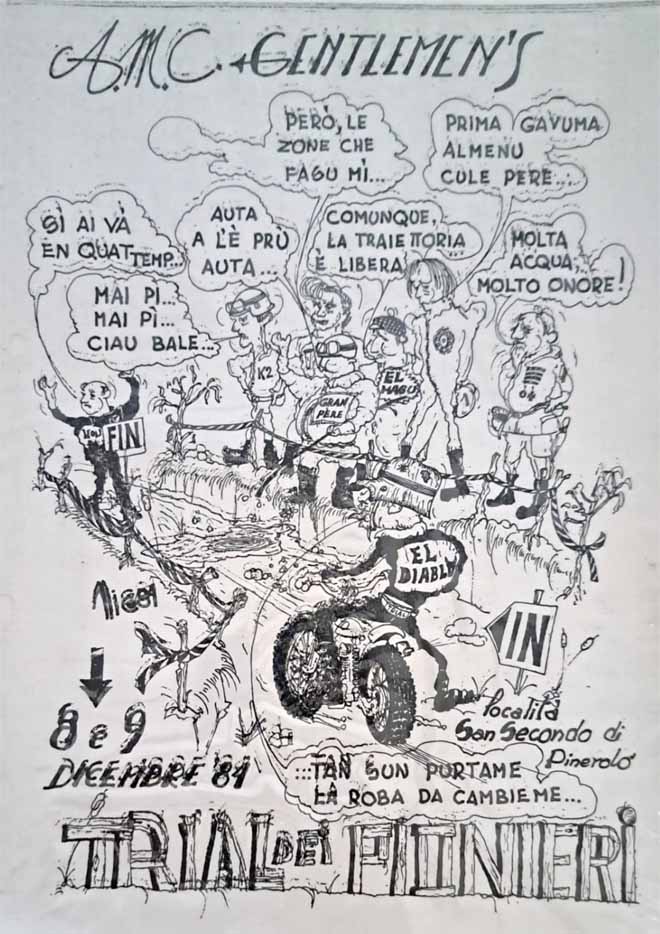
la simpatica vignetta di tutte le edizioni in dialetto piemontese

la tabella degli Handicap, quando fu introdotta la categoria BIBERON
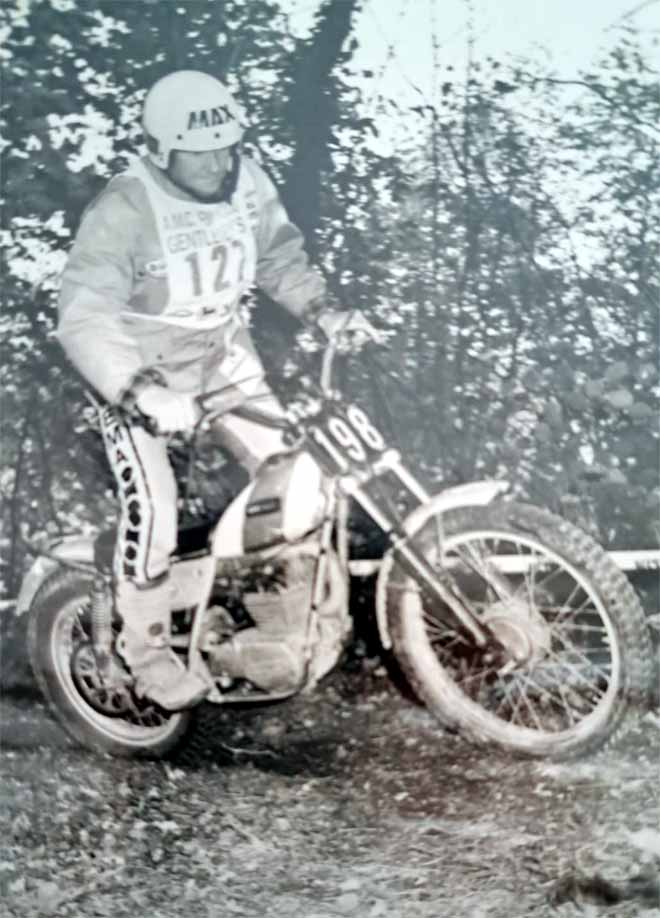

il primo Campione Italiano nel 1974 e 1975, Giovanni Tosco, presente a tutte le edizioni

il presidente del Gentlemen's Ferruccio Garis intento a dare i cartellini

partenza sempre libera, ma regolata a distanza di un minuto
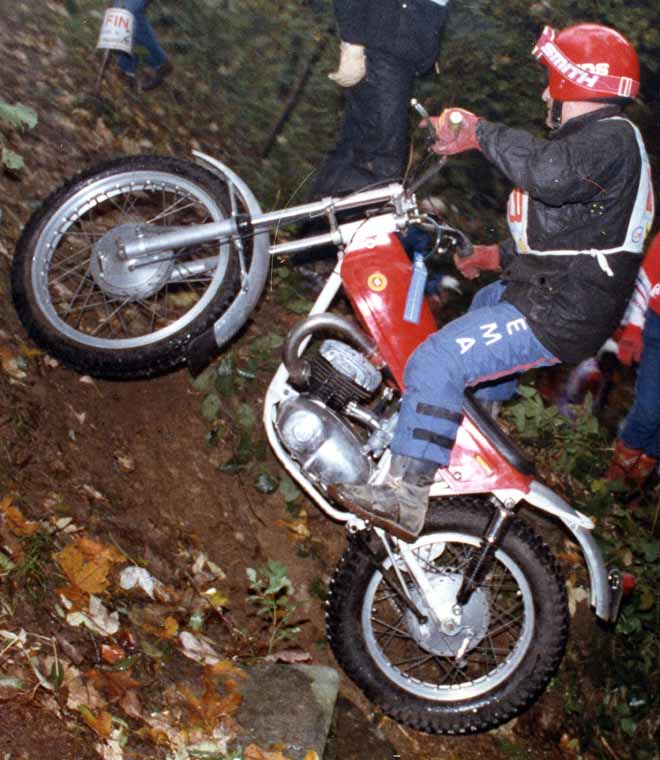

Giovanni Priotti un vero pioniere della specialità

Sammy Miller, presente alle edizioni del 1994 e 1995
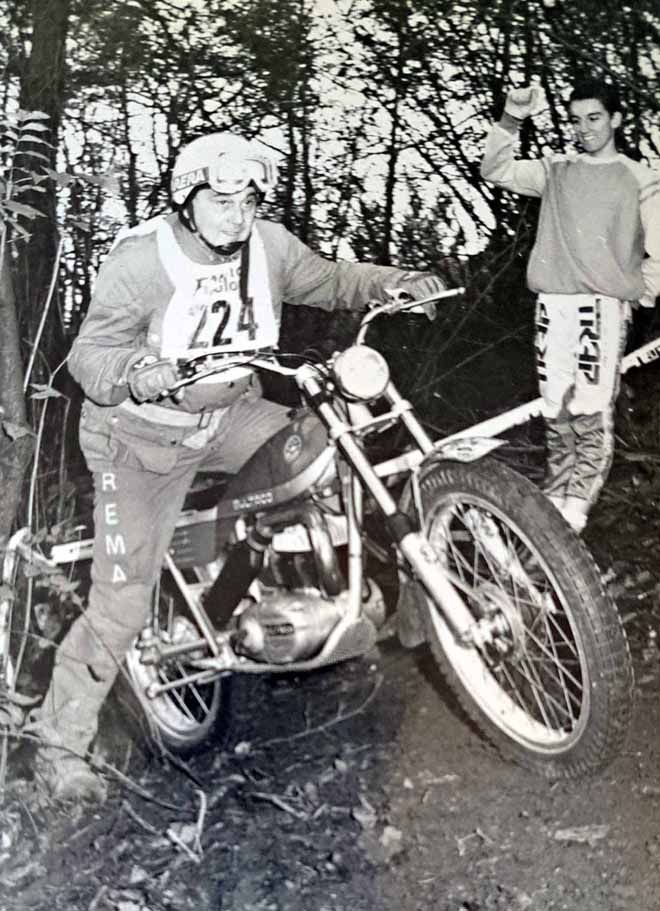
Giancarlo Bertani, passato a miglior vita in questi giorni a 90 anni, un mago della meccanica di quei tempi
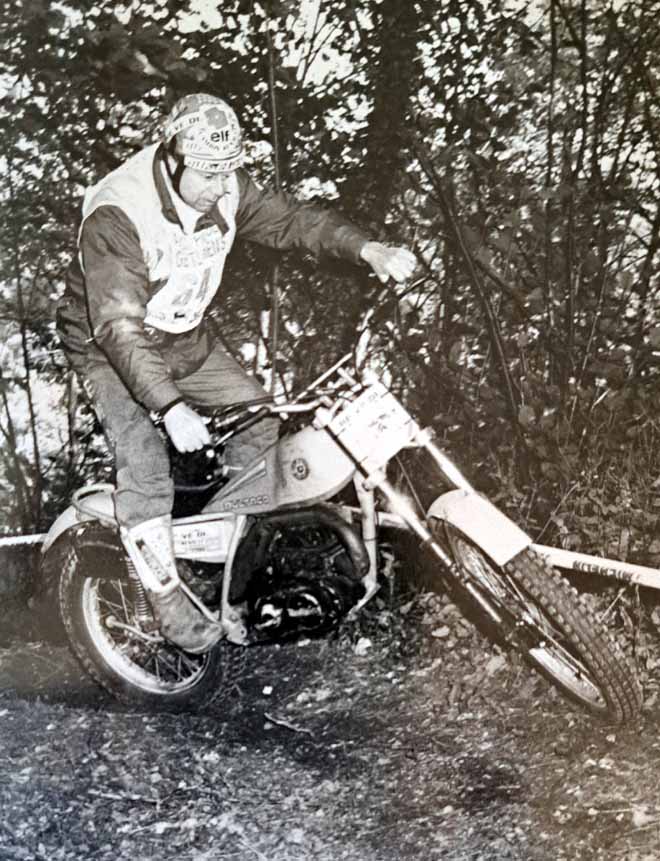
Piero Balmas, un altro pioniere protagonista di questa gara

Francesco Odetto, un pioniere appassionato al punto di seguire da spettatore insieme alla moglie diverse prove del mondiale dei giorni nostri, soprattutto all'estero

sempre molto ricca la premiazione, quindi affollata ...

la locandina della nuova edizione
---------------------------------------------------------------------------------------

